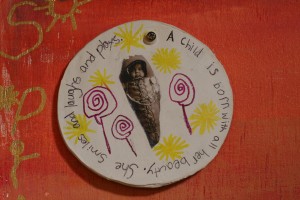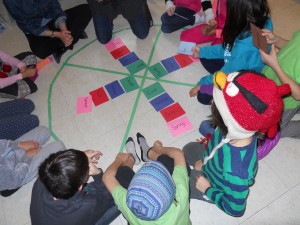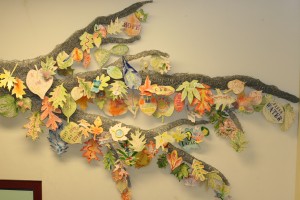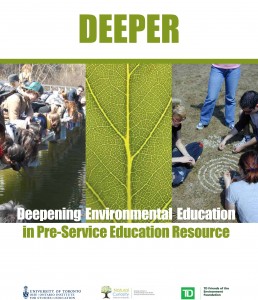I was spending a lot of time in gardens over the summer, and some in school gardens.ô Iãm always on the lookout for ideas about how art can be incorporated into school yards as I think itãs a great tool to raise environmental awareness and even bring about environmental change.ô There is lots of experimentation going on in Toronto in this area, and it is exciting to find a new artwork in a schoolyard to support student learning.ô If youãre looking for ideas in this regard, Pinterest has lots of ideas in visual forms.ô You can also refer to a great book called Asphalt to Ecosystems:ô Design Ideas for Schoolyard Transformation by Sharon Gamson Danks (published by newvillagepress).ô Sharon is a Californian consultant on schoolyard greening, and has travelled around the world photographing amazing schoolyard designs.ô While any aspect of a greening project could be considered a form of aesthetic design, from the pathways to the plantings to the play equipment, she has included a few chapters dedicated to the diverse and stimulating roles that art can play to enhance childrenãs ecological literacy. ô ô Check out the gallery on my website for more ideas on this topic.
Where Do Eco-Art Ideas Come From?
At the start of another new year at OISE, we are in planning mode to create a few new eco-artworks with our students.ô These projects have been well-received, and are successfully drawing attention to creating a culture of sustainability in our institution.ô We’ve been very lucky to have support from our CAO in this as she provides financial support to make them happen…it would be hard to make projects happen with no budget.ô But once the funding is in place, I’m often asked ‘where do you start’?ô How do you find the spark of inspiration that begins the creative process?ô I draw on a variety of sources for this – sometimes it comes from campaigns or organizations that are addressing an important environmental issue that we want to support.ô In other instances it has been a way to raise awareness about an issue we know is of concern to our organization specifically (our FLAP project is an example).ô Often it’s a technique or image from an existing artwork that inspires, triggering the reaction “I want to try that!” (This is a great way to push yourself to move beyond the art-making strategies you feel most comfortable with.)ô ô And at times it has been a request from someone in the organization to help to address a specific concern (aesthetic or environmental.)ô We’ve already got a project underway as an example of the latter; we were approached to provide new artwork for one of the busy meeting rooms in the building.ô This provided an opportunity to improve a space in the building aesthetically, and another way to get across the message about sustainability. This has translated into a series of large-scale photos of our Learning Garden, and will allow the garden to have a permanent, year-round presence inside the building.ô I’ll post photos of this installation here in the next few months as it is completed.
Using Digital Photos for Eco-Artmaking
Digital photography is a great technique to use for environmental art-making ã while itãs not ãno impactã (is anything?), it is low impact.ô For a small amount of electricity students can have so much fun taking photos and then modifying them in so many ways; itãs a great form of recycling!ô I have been using the work of many of environmental photographer/artists in my classroom as starting points for eco-art lessons.ô Canadian Ed Burtynsky is known internationally for his large-scale photos of human impact on the earth; if you havenãt seen his documentary Manufactured Landscapes, it is excellent viewing.ô I havenãt seen his newest one, called Watermark, but reviews of it are also strong.ô (More about his work at http://www.edwardburtynsky.com/ )ô The work of American photographer Peter Menzel is often found in my classroom as well ã his series Hungry World and Material World are fascinating portraits of familiesã consumption around the world; not surprisingly there are great disparities depending on where they live.ô I use his work to introduce eco-justice education and the power of art to raise awareness about inequity and its relationship to the environment.ô (http://www.menzelphoto.com/books/hp.php )ô And finally the work of American Chris Jordan (http://www.chrisjordan.com/gallery/rtn/#silent-spring ) is also useful to introduce how environmental statistics can have a greater impact when given visual form.ô ô Weãre experimenting with photography ourselves at OISE this summer by running a photography contest on our Learning garden – Iãll share the results in a future blog post.
Growing in New Directions
We are at the end of another jam packed year at OISE, so in amongst the classes, field trips and papers, I was very happy to have some time with children to work on a collaborative art project together.ô ICS artô teacher Tara Rousseau generously opened her classroom to me again this year, this time with her grade three class.ô MA student Jennifer Ford-Sharpe also volunteered to help; she was central to the planning and implementation of the project.ô As learning about First Nations peoples is in the gr. 3 social studies curriculum, we used our new Aboriginal Education garden at OISE as the starting point. The students visited the garden in the fall to learn about native plant species and their role in aboriginal culture in Canada, and they made drawings of the plants in situ.ô Back in the classroom they learned about the importance of the four cardinal directions in First Nations cultures, and were inspired by the work of artists Christi Belcourt (Metis), Bill Reid (Haida), Jane Ash Poitras (Cree), and Carl Beam (Ojibway).ô This led the children to work on their own multi-media artworks using paint, clay, photographic transfers, and poetry.ô Their works centred on the importance of the cardinal directions in aboriginal culture and the connections between humans, wildlife, and plants.ô Such rich environmental learning!ô A few photos of the results are below, with more on the OISE website, found here:ô http://www.oise.utoronto.ca/ese/ESE_in_Practice/Eco-Art_Projects.html
Thanks to Tara and Jennifer for their partnership in facilitating this wonderful eco-art project!
Turning Over a New Leaf
How can you help your students turn over a new leaf when it comes to living more sustainably on the earth?ô I asked my pre-service students to do just that this year, and not surprisingly they gave a range of responses, from recycling to upcycling, to doing more with less, to hatching new ideas.ô This inspired their latest eco-art project, which has just been installed at OISE.ô I introduced them to the field of eco-art in a workshop, and then together we created over a hundred clay leaves that capture their ideas in both text and image, which were glazed and fired.ô Working with artist/student Angela Johnson, we created a large metal branch on which to hang the vibrant leaves.ô As this work hangs in our stairwell as part of the Take the Stairs energy conservation campaign, we hope that Turning over a new Leaf will help others think about how they can take positive change towards sustainability in their lives and those of their students, one step at a time!
Next Gen of Eco-art Educators
Itãs conference season, and I was lucky to attend NAEA at the end of March – a good reason to get out of the grips of a harsh winter here in Toronto.ô The best part is learning about what other educators and artists are doing, and this year was no exception.ô Two up and coming educators made an impression on me with their enthusiasm and experiments into eco-art education, and it was a pleasure to meet them in person at NAEA for the first time.ô One is Jamia Weir (in a photo with me below), who is using her West Hollywood classroom to do her graduate research into eco-art ed, experimenting with eco-fashion design and art in school gardens.ô The second art educator is Jennifer Sams, a photographer and educator in Georgia ã she has a great website with lots of resources and eco-artists listed for easy reference.ô Check it out at:ô http://greenarted.weebly.com/eco-artistsenvironmental-artists1.html ô Jennifer has a Pinterest board going on eco-art, as do I ã Iãm finding it to be an excellent way of maintaining a set of visual inspirations for sharing with pre-service students; this digital tool is well-worth using to start your own board!
Going DEEPER
I have been focusing specifically on eco-art education in this blog since its inception, but have just finished working on a major document related to environmental and sustainability education and so would like to share it here.ô Called DEEPER – the Deepening Environmental Education in Pre-Service Education Resource ã it aims to support and inspire faculty, staff, and students to deepen the implementation of environmental education in initial teacher education programs across the province.
ô This resource guide is a substantial publication that is the first of its kind.ô It was a collaborative effort informed by the input of over 60 participants of the DEEPER provincial roundtable that we hosted at OISE last May.ô Since that time, we have coordinated a team of writers and reviewers from faculties of education across Ontario who have shared strategies, practices, and resources to encourage initial teacher educators, teacher candidates and staff to improve the breadth and depth of environmental education in their programs, faculties and institutions.
ô It has been a rewarding journey working on the DEEPER guide; I have learned so much about the field of environmental education, and its practice in Ontario teacher education programs, and there is so much more going on than I had anticipated.ô Most importantly I have forged new connections with other environmental educators working across the province, which was in fact one of our motivations for writing this document in the first place.ô I hope you will take the time to look through it; so much of what we have compiled could be applied in school or community settings.ô I certainly hope that it helps you to go DEEPER into your own practice of environmental education moving forward.
The DEEPER guide can be found at:ô ô
http://www.oise.utoronto.ca/ese/DEEPER.htmlô
Cape Farewell moves to Toronto
Toronto has been the site of an innovative project on climate change and sustainability this fall, organized by the team at Cape Farewell [http://www.capefarewell.com/]. Started up by artist David Buckland in 2001 as a way to bring artists and scientists together to address climate change, Cape Farewell uses ãthe notion of expedition – Arctic, Island, Urban and Conceptual – to interrogate the scientific, social and economic realities that lead to climate disruption, and to inspire the creation of climate focused artã (from their website).ô The variety of projects this group has created internationally is fascinating, from trips to the Arctic, to art/science exhibitions, books, websites, performances and other cultural events.ô ô The Cape Farewell Foundation now has a Toronto office, which has led to a months-long cultural festival focused on climate change, and culminates in a conference here in February.ô For more on the range of events that they are hosting, visit http://www.capefarewellfoundation.com/projects/carbon-14.html
TED Talks on Environmental Art-making
Iãve been finding some great TED talks related to environmental art-making that I wanted to share:
Natalie Jeremijenko is a prof at NYU, and runs something she calls the ãEnvironmental Health Clinicã which features ãcreative health solutionsã for the environment.ô Her art projects are certainly creative, sometimes digital and often humourous ã well worth viewing.ô
Bjarke Ingels is a Danish architect who designs buildings that have a naturalistic design with stunning views – and perform nature-like functions to make them sustainable.
Canadian artist Edward Burtynsky won the 2005 TED prize for his large scale photos of some of the worldãs most challenging environmental issues, from quarries in Italy, to shipyards in Bangladesh, to the tar sands in Canada.ô
Margaret Wertheim works with her sister Christine to raise awareness about the environmental challenges facing the worldãs coral reefs, achieved through an interdisciplinary, interactive project that uses math, biology, and crocheting.
Iãm sure there are others, but these are my favourites so farãÎinspiring takes on what can happen when you bring creativity and environmental activism together!
The Environmental Angels Project
June proved to be a very busy month, full of environmental artmaking both inside OISE and in our partner schools.ô I was fortunate to be asked to do an inaugural eco-art project at Holy Angels Catholic School in Toronto’s west end this spring, and wanted to share the results.ô
ô This project was intended as a way to get the school community thinking more sustainably by starting a schoolyard collection of student eco-artwork.ô As the theme of angels runs deep in this school, we came up with the idea of focusing on the importance of stewardship by asking students to think about what they want to protect in the local environment.ô The students from classes in grades four and eight worked in pairs to photograph features of their neighbourhood that they value, and then used these to inform large scale drawings.ô The drawings were then traced onto plywood, cut out with a jigsaw, and painted by the pairs of young artists together.ô The resulting installation covers both side of the school fence.ô To finish, students wrote poems about the images in their paintings, shared in a poetry slam.
ô Despite the school being on the edge of an industrial zone on one side, and a suburban neighbourhood on the other, the student artists all chose natural features of their neighbourhood as the subjects of their paintings, from plants and trees to squirrels and snails.ô A few thought about the ‘big picture’ by focusing on water, the sky, or the sun.ô And they seemed to get the concept that the same practices used by environmental artists (like reducing waste, decreasing material toxicity, and cleaning up the mess you make) could be used by all of us to better protect the local environments in which we live.ô I hope this learning about stewardship will stay with them in the years to come.
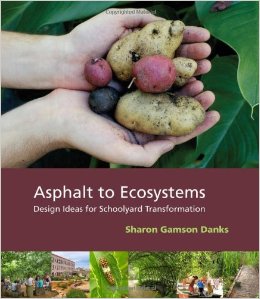
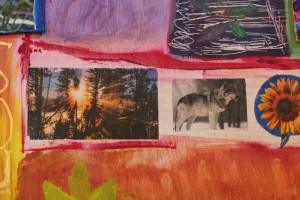 ô ô
ô ô 